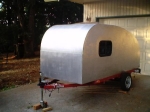If you are using a harbor freight trailer, I suggest you be absolutely certain the HF trailer and the floor to be attached are flat and square BEFORE attaching the floor, and especially before the walls.
Take it from experience, if the trailer flexes even a quarter of an inch over the 8 feet, you'll complicate all of the following build.
Harbor Freight Trailer - Square?
13 posts
• Page 1 of 1
-

darkroomsource - Teardrop Advisor
- Posts: 64
- Joined: Thu Oct 28, 2004 12:08 pm
- Location: Silverton, Oregon
Once the walls are on, the shape is pretty much set... you are right....
I set mine on some jack stands and got the deck trued up.. didn't take it off the stands till the walls were on and the tear is nice and square..
I set mine on some jack stands and got the deck trued up.. didn't take it off the stands till the walls were on and the tear is nice and square..
-

Arne - Mr. Subject Line
- Posts: 5383
- Images: 96
- Joined: Fri Aug 13, 2004 12:25 pm
- Location: Middletown, CT

